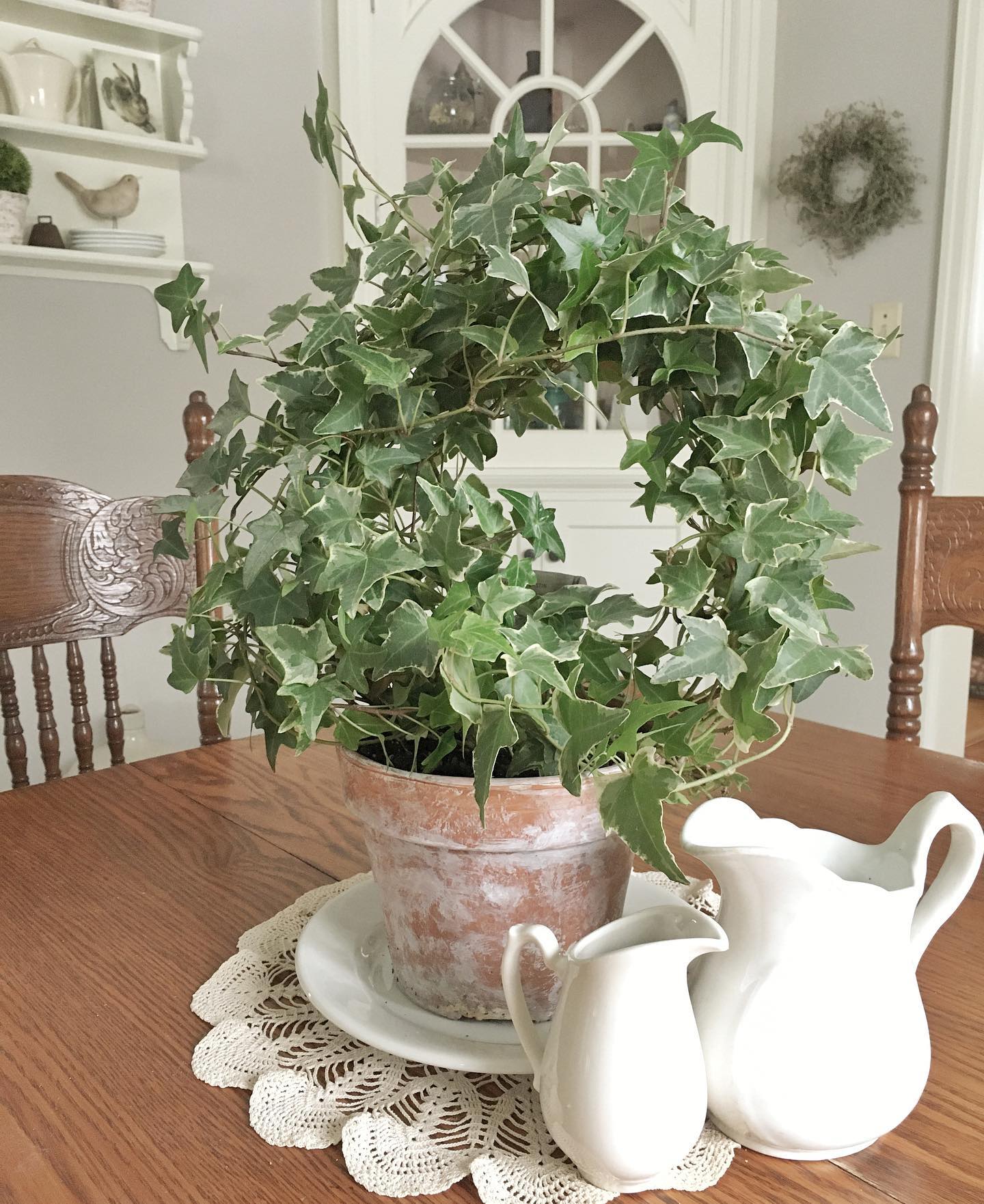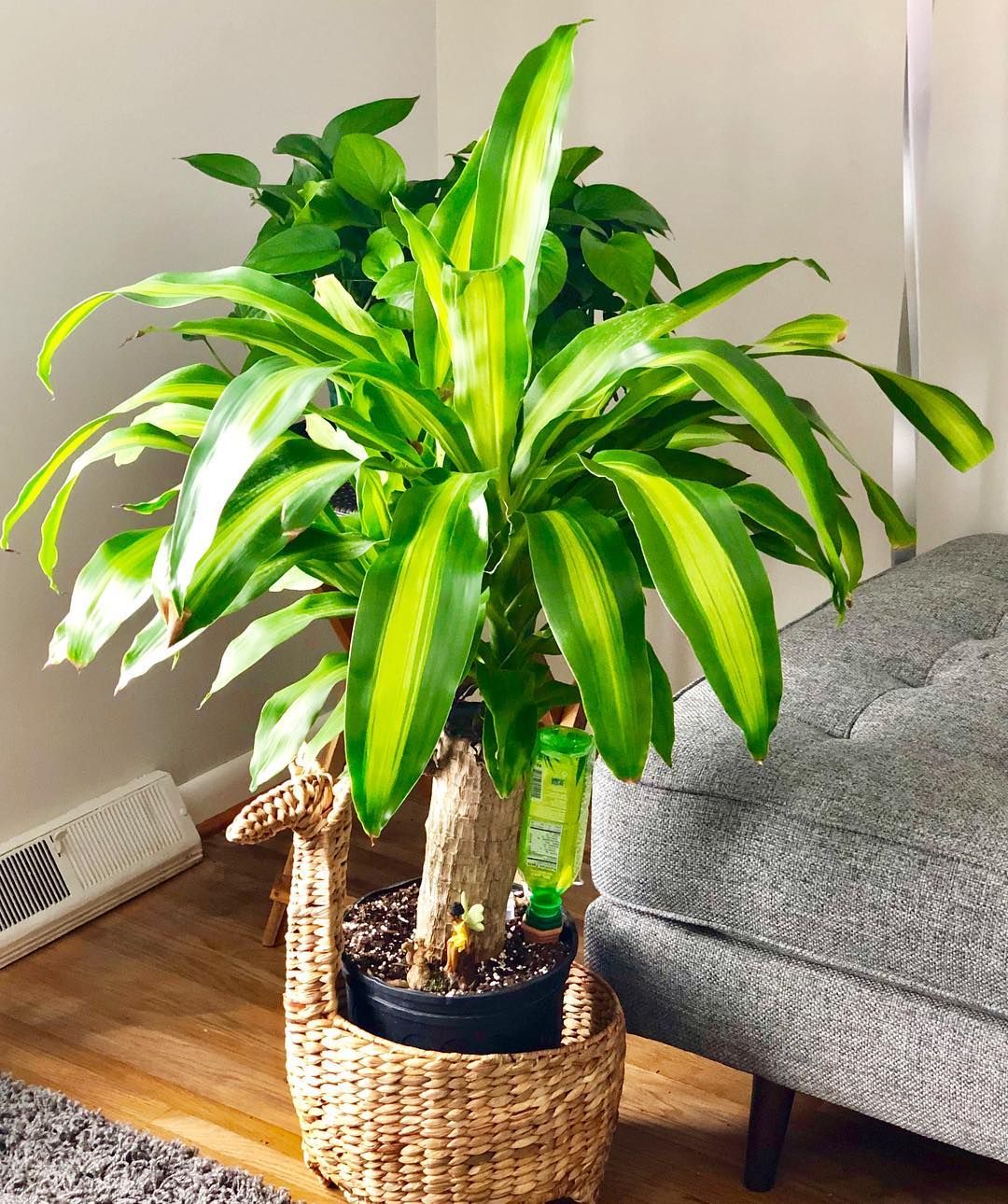1. Snake Plant (Sansevieria trifasciata)

- Why It’s Great: Removes toxins like formaldehyde and benzene. Upright, sword-like leaves add a modern touch.
- Light: Tolerates low to bright, indirect light.
- Watering: Every 2-3 weeks, allowing soil to dry out.
- Size: Up to 3 feet tall.
- Soil: Well-draining, sandy soil.
- Feeding: Sparingly with balanced liquid fertilizer.
- Flowering: Rarely indoors.
2. Spider Plant (Chlorophytum comosum)

- Why It’s Great: Excellent at removing formaldehyde and xylene. Long, slender leaves and arching stems.
- Light: Bright, indirect light; tolerates low light.
- Watering: When top inch of soil is dry.
- Size: Up to 2 feet tall.
- Soil: Well-draining potting mix.
- Feeding: Monthly with balanced liquid fertilizer.
- Flowering: Small, white flowers on long stems.
3. Peace Lily (Spathiphyllum)

- Why It’s Great: Removes ammonia, benzene, formaldehyde. Glossy leaves and white flowers.
- Light: Low to bright, indirect light.
- Watering: When top inch of soil is dry.
- Size: Up to 3 feet tall.
- Soil: Well-draining potting mix.
- Feeding: Monthly with balanced liquid fertilizer.
- Flowering: White, spathe-like flowers.
4. Boston Fern (Nephrolepis exaltata)

- Why It’s Great: Removes formaldehyde and xylene. Lush, arching fronds.
- Light: Bright, indirect light; tolerates low light.
- Watering: Keep soil consistently moist.
- Size: Up to 3 feet tall.
- Soil: Well-draining potting mix.
- Feeding: Monthly with balanced liquid fertilizer.
- Flowering: Non-flowering.
5. Golden Pothos (Epipremnum aureum)

- Why It’s Great: Removes formaldehyde, carbon monoxide. Heart-shaped leaves, perfect for hanging baskets.
- Light: Low to bright, indirect light.
- Watering: When top inch of soil is dry.
- Size: Vines several feet long.
- Soil: Well-draining potting mix.
- Feeding: Monthly with balanced liquid fertilizer.
- Flowering: Rarely indoors.
6. Aloe Vera (Aloe barbadensis miller)

- Why It’s Great: Clears formaldehyde and benzene. Succulent, gel-filled leaves.
- Light: Bright, indirect sunlight.
- Watering: Deeply but infrequently, soil dry between.
- Size: Up to 2 feet tall.
- Soil: Cactus potting mix.
- Feeding: Sparingly in spring and summer.
- Flowering: Yellow tubular flowers.
7. Rubber Plant (Ficus elastica)

- Why It’s Great: Removes airborne toxins, especially formaldehyde. Large, glossy leaves.
- Light: Bright, filtered light; tolerates partial shade.
- Watering: Soil moist in growing season, less in winter.
- Size: Up to 10 feet indoors.
- Soil: Well-draining, loamy soil.
- Feeding: Diluted liquid fertilizer every two weeks in season.
- Flowering: Rarely indoors.
8. English Ivy (Hedera helix)

- Why It’s Great: Removes benzene, formaldehyde, xylene, toluene. Ideal for hanging baskets or climbing.
- Light: Moderate to low indirect light.
- Watering: Keep soil moderately moist.
- Size: Vines up to 10 feet long indoors.
- Soil: Rich, humusy, well-draining soil.
- Feeding: General all-purpose fertilizer monthly.
- Flowering: Small, insignificant flowers.
9. Areca Palm (Dypsis lutescens)

- Why It’s Great: Humidifies air, removes xylene and formaldehyde. Tropical flair with feathery fronds.
- Light: Bright, indirect light; tolerates lower light.
- Watering: Keep soil lightly moist in summer, less in winter.
- Size: Up to 6-7 feet tall.
- Soil: Peat-based potting soil with good drainage.
- Feeding: Lightly with balanced fertilizer in growing season.
- Flowering: Rarely indoors.
10. Bamboo Palm (Chamaedorea seifrizii)

- Why It’s Great: Filters out benzene, trichloroethylene, formaldehyde. Lush, tropical leaves.
- Light: Bright, indirect light; adapts to lower light.
- Watering: Regularly to keep soil consistently moist.
- Size: Up to 5-7 feet tall.
- Soil: Well-draining potting soil.
- Feeding: Monthly with liquid fertilizer in growing season.
- Flowering: Occasionally small, yellow flowers indoors.
11. Dracaena Marginata (Dragon Tree)

- Why It’s Great: Effective at removing xylene, trichloroethylene, and formaldehyde from the air. Striking, with narrow leaves and a woody stem.
- Light: Prefers bright, indirect light but can tolerate lower light.
- Watering: Water when the top soil becomes dry.
- Size: Can grow up to 6 feet tall.
- Soil: Well-draining potting soil.
- Feeding: Feed every month during the growing season with liquid fertilizer.
- Flowering: Rarely flowers indoors.
12. Philodendron (Philodendron spp.)

- Why It’s Great: Known for its ability to remove high levels of formaldehyde. Heart-shaped leaves are vibrant and inviting.
- Light: Thrives in medium indirect light; can tolerate low light.
- Watering: Water when the top inch of soil is dry.
- Size: Varies; some species can climb or trail several feet.
- Soil: Loose, well-draining potting mix.
- Feeding: Monthly during the growing season with a balanced fertilizer.
- Flowering: Does not flower often.
13. Chinese Evergreen (Aglaonema)

- Why It’s Great: Excellent at removing air toxins such as benzene and formaldehyde. Features striking variegated leaves.
- Light: Low to moderate, indirect light.
- Watering: Keep soil consistently moist.
- Size: Up to 3 feet tall.
- Soil: Well-draining potting soil.
- Feeding: Feed lightly with liquid fertilizer during the growing season.
- Flowering: Occasionally produces small, white flowers.
14. ZZ Plant (Zamioculcas zamiifolia)

- Why It’s Great: ZZ plant is very low maintenance and can remove toxins like xylene, toluene, and benzene from indoor air.
- Light: Low to bright indirect light.
- Watering: Allow soil to dry out between waterings.
- Size: Up to 3 feet tall.
- Soil: Well-draining potting mix.
- Feeding: Minimal; feed once every three months during the growing season.
- Flowering: Rarely flowers.
15. Gerbera Daisy (Gerbera jamesonii)

- Why It’s Great: Effective at removing benzene, trichloroethylene, and will help you sleep better by emitting oxygen at night.
- Light: Needs a lot of light, prefer bright sunlight.
- Watering: Keep soil uniformly moist and well-drained.
- Size: Up to 18 inches tall.
- Soil: Well-draining soil rich in organic material.
- Feeding: Feed monthly during the growing season with a water-soluble fertilizer.
- Flowering: Produces large, colorful flowers.
16. Weeping Fig (Ficus benjamina)

- Why It’s Great: Known for its efficiency in purifying the air of formaldehyde, xylene, and toluene.
- Light: Prefers bright, indirect light but can tolerate some direct light.
- Watering: Water when the top inch of soil is dry; reduce watering in winter.
- Size: Can grow up to 10 feet tall.
- Soil: Well-draining, rich potting soil.
- Feeding: Feed with liquid fertilizer every month during spring and summer.
- Flowering: Rarely flowers indoors.
17. Kimberly Queen Fern (Nephrolepis obliterata)

- Why It’s Great: Excellent at removing toxins like formaldehyde and indoor pollutants. More upright and does not shed as much as other ferns.
- Light: Thrives in bright, indirect light.
- Watering: Keep soil consistently moist.
- Size: Up to 3 feet tall.
- Soil: Well-draining, loamy soil.
- Feeding: Feed monthly with a balanced fertilizer during the growing season.
- Flowering: Non-flowering plant.
18. Bird’s Nest Fern (Asplenium nidus)

- Why It’s Great: Helps remove pollutants such as xylene and toluene. Unique, ripple-edged fronds add interest and texture.
- Light: Prefers low to medium indirect light.
- Watering: Keep the soil consistently moist but not soggy.
- Size: Can grow up to 2 feet tall.
- Soil: Rich, well-draining organic mix.
- Feeding: Fertilize every two months during the growing season.
- Flowering: Rarely flowers indoors.
19. Parlor Palm (Chamaedorea elegans)

- Why It’s Great: Effective at removing indoor air pollutants, especially formaldehyde. Perfect for indoor environments as it requires little light.
- Light: Low to moderate indirect light.
- Watering: Water when the top inch of soil is dry.
- Size: Up to 4 feet tall.
- Soil: Well-draining potting soil.
- Feeding: Fertilize sparingly, only a few times a year.
- Flowering: Occasionally produces small flowers indoors.
20. Corn Plant (Dracaena fragrans ‘Massangeana’)

- Why It’s Great: Excellent at removing several types of toxins from the air, including formaldehyde. Attractive, with striped leaves.
- Light: Prefers moderate to bright indirect light.
- Watering: Water when the top inch of soil dries out.
- Size: Can grow up to 6 feet tall.
- Soil: Well-draining loamy soil.
- Feeding: Feed with liquid fertilizer every month during the growing season.
- Flowering: Occasionally produces fragrant white flowers.
21. Lady Palm (Rhapis excelsa)

- Why It’s Great: Effective at removing ammonia and other toxins from the air, making it ideal for homes and offices.
- Light: Prefers bright, indirect light but can tolerate lower light conditions.
- Watering: Water when the soil feels dry to the touch.
- Size: Can grow up to 6 feet tall.
- Soil: Prefers rich, well-draining soil.
- Feeding: Feed with a balanced fertilizer every few months.
- Flowering: Rarely flowers indoors.
22. Fiddle Leaf Fig (Ficus lyrata)

- Why It’s Great: Known for its large, leathery leaves, the Fiddle Leaf Fig is not only decorative but also good at improving indoor air quality by removing toxins.
- Light: Requires bright, indirect light.
- Watering: Water moderately, allowing the soil to dry out slightly between waterings.
- Size: Can grow up to 10 feet tall.
- Soil: Well-draining soil.
- Feeding: Feed with a liquid fertilizer during the growing season every month.
- Flowering: Does not typically flower indoors.
23. Janet Craig (Dracaena deremensis ‘Janet Craig’)

- Why It’s Great: Known for its ability to filter out trichloroethylene, benzene, and formaldehyde from the air.
- Light: Thrives in low light conditions.
- Watering: Water when the soil surface becomes dry.
- Size: Can grow up to 10 feet tall.
- Soil: Well-draining, rich organic mix.
- Feeding: Feed every month during the growing season with liquid fertilizer.
- Flowering: Rarely flowers indoors.
24. Moth Orchid (Phalaenopsis sp.)

- Why It’s Great: Effective at removing xylene from the air and beautifying any space with its colorful blooms.
- Light: Prefers moderate, indirect light.
- Watering: Keep the soil slightly moist.
- Size: Up to 2 feet tall.
- Soil: Loose, well-draining orchid mix.
- Feeding: Feed with a balanced fertilizer every other watering during the growing season.
- Flowering: Blooms can last for weeks.
25. Cast Iron Plant (Aspidistra elatior)

- Why It’s Great: Extremely tough and able to survive low light and neglect. Known for improving indoor air quality.
- Light: Low to moderate light.
- Watering: Water sparingly; let the soil dry out between waterings.
- Size: Up to 2 feet tall.
- Soil: Rich, well-draining soil.
- Feeding: Minimal; feed only a few times a year.
- Flowering: Rarely flowers indoors.
26. Broadleaf Lady Palm (Rhapis excelsa)

- Why It’s Great: Excellent for removing ammonia and other toxins from the air. Decorative and effective for indoor air quality.
- Light: Prefers moderate to bright indirect light.
- Watering: Water when top inch of soil is dry.
- Size: Up to 6 feet tall.
- Soil: Well-draining, fertile soil.
- Feeding: Feed with balanced fertilizer every month during growing season.
- Flowering: Rarely flowers indoors.
27. Bromeliad (Bromeliaceae)

- Why It’s Great: Enhances indoor air quality by releasing oxygen and removing air pollutants at night.
- Light: Bright, indirect light.
- Watering: Water into the central cup; allow to dry between waterings.
- Size: Up to 2 feet in both height and spread.
- Soil: Fast-draining potting mix.
- Feeding: Minimal; feed with a weak liquid fertilizer during growing season.
- Flowering: Produces vibrant, colorful flowers.
28. Elephant Ear Philodendron (Philodendron domesticum)

- Why It’s Great: Known for its large, showy leaves, which can absorb a wide range of air pollutants.
- Light: Prefers low to moderate indirect light.
- Watering: Keep the soil consistently moist.
- Size: Can grow up to 5 feet tall.
- Soil: Well-draining, rich in organic matter.
- Feeding: Feed monthly with a liquid fertilizer during the growing season.
- Flowering: Rarely flowers indoors.
29. Flamingo Lily (Anthurium andraeanum)

- Why It’s Great: Excellent at removing ammonia, formaldehyde, and other toxins from the air. Known for its waxy, colorful spathes.
- Light: Prefers bright, indirect light.
- Watering: Keep soil consistently moist.
- Size: Up to 3 feet tall.
- Soil: Well-draining, rich potting mix.
- Feeding: Feed every two months with a high-phosphorus fertilizer.
- Flowering: Produces long-lasting flowers throughout the year.
30. Money Tree (Pachira aquatica)

- Why It’s Great: Believed to bring good luck and financial success, and is effective at removing indoor pollutants.
- Light: Thrives in medium to bright indirect light.
- Watering: Water when the top inches of soil dry out.
- Size: Can grow up to 6 feet tall.
- Soil: Well-draining soil.
- Feeding: Feed with a balanced, water-soluble fertilizer every month during the growing season.
- Flowering: Occasionally flowers indoors.







